Wax Moth
|
|
|
|---|
|
Wax Moth |
Life Cycle of Wax Moth
|
|---|
By studying the moth itself we are in a better position to avoid situations in which it will thrive, and thus minimise the damage that it causes.
Beekeepers are likely to see the adult stage of the moth as a first indicator of it's presence. The damage is done by the larvae as they eat themselves to full size.
The life cycle of the wax moth consists of five definable stages. The stages are:-
Egg, Larva, Spinning, Pupa, Adult.
The larvae cause most of the damage to comb, the spinning stage causes the damage to woodwork and finally the adults cause further damage by mating and propagating the species.
Egg StageEggs are laid in cracks between hive parts or in groups on the upper side of cells, but I am unsure of size, colour or precise appearance as the picture has been synthesized from a monochrome photograph. Wax moth eggs hatch into larvae after five to eight days depending on ambient temperature. The eggs require a damp atmosphere to hatch. |
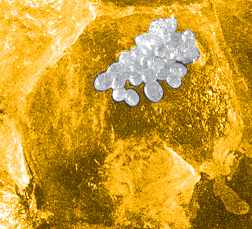
|
|---|
All stages of development are affected to a large extent, by temperature variation. Cool temperatures slow development, and warm temperatures accelerate it.
Larval StageFreshly hatched larvae burrow into the comb towards the midrib, the picture shows the hole a little higher up the cell than generally occurs, often the hole is so low in the cell it forms part of a semicircular gutter that is chewed out of the midrib itself. They are gross feeders and grow and feed for between one and six months depending on ambient temperature. When larval growth is complete they are 16 mm - 20 in length and look rather like a caterpillar. They have a reddish brown, dome shaped head, creamy white bodies with three segments that have a pair of legs and several other body segments, some of which have caterpillar style prolegs. The body colour changes slightly and progressively, with advancing age, to a light grey, occasionally with a pink or salmon pink tinge. The grub eats beeswax, but needs additional detritus within the comb structure (bee cocoons, faeces and pollen) to provide protein. All the while the larva is tunneling it leaves a fine silken tube and charcoal grey granular faeces behind it along the track that it has followed. |
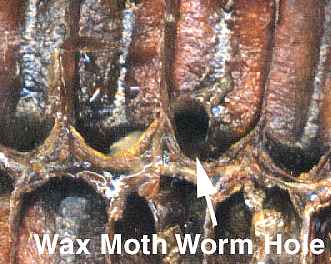
|
|---|
The larvae are at their most destructive in areas that are dark, warm and poorly ventilated. The larvae can detect each other somehow (maybe smell or CO2 emission). If a box of combs that is infested with larvae is banged smartly on to paved ground and then removed, the larvae that are dislodged will set off, in a radial fashion, all in different directions like an expanding star. My deduction is that by dispersing they both lessen competition between the individuals and explore as many as possible different habitats.
|
Foundation is only partially attacked, usually around the edge where the wax fits into the groove in the wooden frame parts. This damage is caused by small larvae that have not found sufficient edible material, they stay small and as they are inadequately fed they often die before reaching adequate size to pupate. I conjecture that in the inadequately fed larvae, at some moults, the new skin remains the same size (or possibly smaller) than the one it replaces. [1] |
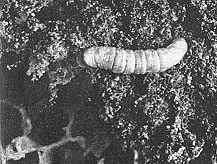
|
|---|
When the larva reaches full size (approaching it's last moult) it starts to spin a coarser silk, with which it makes a cocoon that is papery in texture and very strong. The silk used here is made from the material excavated from the surface on which the larva pupates. The colour of the cocoon is normally white if made on a softwood surface, but I have many dummy frames that have hardboard (masonite) surfaces and cocoons made on these take on the brown colour of the hardboard.
Pupal StageOn completion of the cocoon the larvae itself changes to the pupal stage. Wax moth pupae may hatch rapidly or take up to two months to change to the adult stage depending upon temperature. Pupation can occur within the comb or in the loose debris at the bottom of the hive, but most frequently it is firmly attached to the frame or hive woodwork, particularly in places where there is an internal angle in the woodwork. The cocoon is cemented into a boat shaped cavity the larva chews in the wood. I assume that the cellulose mined from this cavity is converted into the silk that is used to make the cocoon and may account for the difference in silk texture. The pupae are about 12 mm long cigar shaped with the maximum width in the middle at about 3 mm. As the adult has no working mouth parts, I am unsure how it emerges from the cocoon, it certainly comes out of one end and leaves an almost circular flap, but how this is achieved... I do not know. |

|
|---|
Adult (Breeding) StageAdult Wax Moths cause no direct comb damage because their mouth parts are atrophied. They do not feed during their adult life. [2] HabitsMale
|
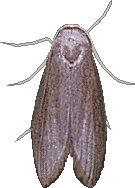
|
|---|
This must be involved with finding a mate.
The vibration may be a by-product of emitting ultrasound.
Infrasound may be used as well as ultrasound (infrasound will travel long distances in solid media).
Wax moths fly mainly at night. During daylight they rest in dark places. They are reluctant to fly, preferring to run... This may be energy saving.
Female
In appearance rather like a clothes moth 10 mm to 15 mm in length, with wings folded at a shallow angle over the top of the body. The wings have scales and are a slate grey or dirty brown sometimes with a minor bronze tinge. The bronze colour becomes more apparent if you squash one with a finger.
Female lesser wax moths can produce up to 300 eggs and prefer to lay them in close proximity to used brood comb.
A component of the wax moth's female sex pheromone 'Nonanal' is also found in
beeswax and may explain how wax moths find suitable wax rich places for laying their eggs.
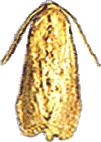
 Eggs up to 1800 in number, are laid in batches of between 50 and 150. The eggs
themselves are laid in cracks between hive parts in little used corners. Greater wax moth
eggs are 0.5 mm across, olive shaped with a white/salmon pink hue. They are not
usually noticed unless specifically looked for.
Eggs up to 1800 in number, are laid in batches of between 50 and 150. The eggs
themselves are laid in cracks between hive parts in little used corners. Greater wax moth
eggs are 0.5 mm across, olive shaped with a white/salmon pink hue. They are not
usually noticed unless specifically looked for.
Physical size adults have bodies about 19 mm long with wing span up to 40 mm.
|
Colour of adults is slightly more pink than the illustration at right. Grubs are pearly white initially, turning mushroom grey as they age. They are larger than Achroia grisella larvae and more tapered at the back end. |

|
|---|
|
The cocoons are larger and the pupae inside them are a light golden brown, There is more silk produced that almost knits the frames together. The damage to woodwork is considerable as the pupating grubs gnaw deep scallops in the woodwork. I have personally seen frame parts that have been perforated by larvae. The damage shown at right is only a medium level of infestation... I have seen much worse cases. This damage is further exacerbated by sheer numbers of pupae involved. |
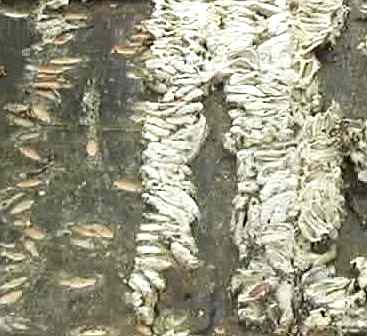
|
|---|
Males are slightly smaller than females and have a scalloped leading edge to the wings. (I speculate that this scalloping might be a focusing mechanism for ultrasound.)
The greater wax moth flies in daylight even less than the lesser variety and if exposed to light will often scuttle away. Such dislike of light applies to the larvae of Galleria mellonella as well as the adults.
| Ref [1] | Larval Development, - Prof. James Beaumont, Cambridge University |
| Ref [2] |
Jean-Daniel Charriere & Anton Imdorf...
Swiss Federal Dairy Research Station Bee Department, Liebefeld, 3003 Bern, Switzerland |
|